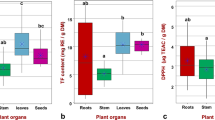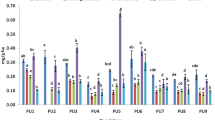Abstract
The changes in total phenolics, flavonoids, tannins, valerenic acid, and antioxidant activity were assessed in 25 populations of Valeriana jatamansi sampled from 1200 to 2775 m asl and four habitat types of Uttarakhand, West Himalaya. Significant (p < 0.05) variations in total phenolics, flavonoids, valerenic acid, and antioxidant activity in aerial and root portions and across the populations were observed. Antioxidant activity measured by three in vitro antioxidant assays, i.e., 2,2′-azino-bis(3-ethylbenzothiazoline-6-sulphonic) (ABTS) radical scavenging, 2,2′-diphenyl-1-picryylhydrazyl (DPPH) free radical scavenging, and ferric-reducing antioxidant power (FRAP) assays, showed significant (p < 0.05) differences across the populations. However, no clear pattern was found in phytochemicals across the altitudinal range. Among habitat types, (pine, oak, mixed forest, and grassy land), variation in phytochemical content and antioxidant activity were observed. Equal class ranking, neighbor-joining cluster analysis, and principal component analysis (PCA) identified Talwari, Jaberkhet, Manjkhali, and Khirshu populations as promising sources with higher phytochemicals and antioxidant activity. The results recommended that the identified populations with higher value of phytochemicals and antioxidants can be utilized for mass multiplication and breeding program to meet the domestic as well as commercial demand.




Similar content being viewed by others
References
Schmidt, B., Ribnicky, D. M., Poulev, A., Logendra, S., Cafalu, W. T., & Raskin, I. (2008). A natural history of botanical therapeutics. Metabolism, Clinical and Experimental, 57, S3–S9.
KIT (2003). Cultivating a healthy enterprise. In Bulletin 350 Royal Tropical Institute, Amsterdam, The Netherlands.
Jugran, A.K. (2013). Fingerprinting phytochemical and genetic variations in Valeriana jatamansi and V. himalayana in Uttarakhand. Ph. D. Thesis, in Biotechnology submitted to Kumaun University, Nainital, Uttarakhand India.
Becker, H., & Chavadeoi, S. (1985). Valepotriate production of normal and colchicine-treated cell suspension cultures of Valeriana wallichii. Journal of Natural Products, 48, 17–21.
Bounthanh, C., Bergmann, C., Beck, J. P., Hagg-Berrurier, M., & Anton, R. (1981). Valepotriates, a new class of cytotoxic and antitumor agents. Planta Medica, 41, 21–28.
Thies, P. W. (1968). Linarin-isovalerianate, a currently unknown flavonoid from Valeriana wallichii. Planta Medica, 16, 363–371.
Ron, B. H., Willis, C. V., Bone, K., & Morgan, M. (2000). Herbal products: active constituents, mode of action and quality control. Nutrition Research Reviews, 13, 47–77.
Marder, M., Viola, H., Wasowski, C., Fernandez, S., Medina, J. H., & Paladini, A. C. (2003). 6-methylapigenin and hesperidins: new Valeriana flavonoids with activity on the CNS. Pharmacology and Biological Behavior, 75, 537–545.
Singh, N., Gupta, A. P., Singh, B., & Kaul, V. K. (2006). Quantification of valeric acid in Valeriana jatamansi and Valeriana officinalis by HPTLC. Chromatographia, 63, 209–213.
Bhatt, I. D., Dauthal, P., Rawat, S., Gaira, K. S., Jugran, A., Rawal, R. S., & Dhar, U. (2012). Characterization of essential oil composition, phenolic content, and antioxidant properties in wild and planted individuals of Valeriana jatamansi Jones. Scientia Horticulturae, 136, 61–68.
Singh, R. D., Gopichand Meena, R. L., Sharma, B., Singh, B., Kaul, V. K., & Ahuja, P. S. (2010). Seasonal variation of bioactive components in Valeriana jatamansi from Himanchal Pradesh, India. Industrial Crops and Products, 32, 292–296.
Gautier, H., Diakou-Verdin, V., Bénard, C., Reich, M., Buret, M., Bourgaud, F., Poessel, J. L., Caris-Veyrat, C., & Génard, M. (2008). How does tomato quality (sugar, acid, and nutritional quality) vary with ripening stage, temperature, and irradiance? Journal of Agriculture and Food Chemistry, 56, 1241–1250.
Andola, H. C., Gaira, K. S., Rawal, R. S., Rawat, M. S. M., & Bhatt, I. D. (2010). Habitat dependent variation in berberine content of Berberis asiatica Roxb. Ex. DC. In Kumaon, western Himalaya. Chemistry and Biodiversity, 7, 415–420.
Rawat, S., Bhatt, I. D., & Rawal, R. S. (2011). Total phenolic compounds and antioxidant potential of Hedychium spicatum Buch. Ham. ex D. Don in West Himalaya, India. Journal of Food Componant Analysis, 24, 574–579.
Sundaresan, V., Shani, G., Verma, R. S., Padalia, R. C., Mahrotra, S., & Thul, S. T. (2012). Impact of geographic range on genetic and chemical diversity of Indian Valerian (Valeriana jatamansi) from northwestern Himalaya. Biochemical Genetics, 50, 797–808.
Jugran, A. K., Bhatt, I. D., Rawal, R. S., Nandi, S. K., & Pande, V. (2013). Patterns of morphological and genetic diversity of Valeriana jatamansi Jones in different habitats and altitudinal range of West Himalaya, India. Flora Morphology, Distribution, Functional Ecology of Plants, 208, 13–21.
Rawal, R. S., Pandey, B., & Dhar, U. (2003). Himalayan forest database—thinking beyond dominants. Current Science, 84, 990–994.
Andola, H. C., Rawal, R. S., & Bhatt, I. D. (2011). Comparative studies on the nutritive and anti-nutritive properties of fruits in selected Berberis species of West Himalaya, India. Food Research International, 44, 2352–2356.
Jugran, A., Rawat, S., Dauthal, P., Mondal, S., Bhatt, I. D., & Rawal, R. S. (2013). Association of ISSR markers with some biochemical traits of Valeriana jatamansi Jones. Industrial Crops and Products, 44, 671–676.
Upton, R. (1999). Commercial sources and handling. In R. Upton (Ed.), Valerian root, Valeriana officinalis, analytical, quality control and therapeutic monograph (pp. 6–7). Santa Cruz: American Herbal Pharmacopoeia.
Jugran, A. K., Bhatt, I. D., & Rawal, R. S. (2015). Identification of ISSR markers associated with valerenic acid and antioxidant activity in Valeriana jatamansi Jones in western Himalaya. Molecular Breeding, 35, 1–14. doi:10.1007/s11032-015-0241-5.
Cruz, A. G., Cadena, R. S., Alvaro, M. B. V. B., Sant’Ana, A. S., Oliveira, C. A. F., Faria, J. A. F., et al. (2013). Assessing the use of different chemometric techniques to discriminate low-fat and full-fat yogurts. LWT-Food Science and Technology, 50, 210–214.
Hammer, O., Harper, D. A. T., & Ryan, P. D. (2001). PAST: paleontological statistics software package for education and data analysis. Palaeontologia Electronica, 4, 1–9.
Rawat, S., Andola, A., Giri, L., Dhyani, P., Jugran, A., Bhatt, I. D., & Rawal, R. S. (2014). Assessment of nutritional and antioxidant potential of selected vitality strengthening medicinal plants. International Journal of Food Properties, 17, 703–712.
Ghasemzadeh, A., Jaafar, H. Z. E., Rahmat, A., Wahab, P. E. M., & Halim, M. R. A. (2010). Effect of different light intensities on total phenolics and flavonoids synthesis and anti-oxidant activities in young ginger varieties (Zingiber officinale Roscoe). International Journal of Molecular Sciences, 11, 3885–3897.
Alonso-Amelot, M. E., Oliveros-Bastidas, A., & Calcagno-Pisarelli , M. (2007). Phenolics and condensed tannins of high altitude Pteridium arachnoideum in relation to sunlight exposure, elevation, and rain regime. Biochemical Systematics and Ecology, 35, 1–7.
Oloumi, H., & Hassibi, N. (2011). Study the correlation between some climate parameters and the content of phenolic compounds in roots of Glycyrrhiza glabra. Journal of Medicinal Plant Research, 5, 6011–6016.
Dragovi-Uzelac, V., Savi, Z., Brala, A., Levaj, B., Kovaceveic, D. B., & Bisko, A. (2010). Evaluation of phenolic content and antioxidant capacity of blueberry cultivars (Vaccinium corymbosum L.) grown in the northwest Croatia. Food Technology and Biotechenology, 48, 214–221.
Ahmad, I., Ahmad, M. S. A., Ashraf, M., Hussain, M., & Ashraf, M. Y. (2011). Seasonal variation in some medicinal and biochemical ingredients in Mentha longifolia (L.) Huds. Pakistan Journal of Botany, 43, 69–77.
Binns, S. E., Arnason, J. T., & Baum, B. R. (2002). Phytochemical variation within populations of Echinacea angustifolia (Asteraceae). Biochemical Systematics and Ecology, 30, 837–854.
Tong, L., Wang, Y., Xiong, J., Cui, Y., Zhou, Y., & Yi, L. (2008). Selection and fingerprints of the control substances for plant drug Eucommia ulmodies Oliver by HPLC and LC–MS. Talanta, 76, 80–84.
Devkota, A., Dall Acqua, S., Jha, P. K., & Innocenti, G. (2010). Variation in the active constituent contents in Centella asiatica grown in different habitats in Nepal. Botnica Orientalis- Journal of Plant Science, 7, 43–47.
Gharibi, S., Tabatabaei, B. E. S., Saeidi, G., & Goli, S. A. H. (2015). Effect of drought stress on total phenolic, lipid peroxidation, and antioxidant activity of Achillea species. Applied Biochemistry and Biotechnology. doi:10.1007/s12010-015-1909-3.
Vats, S. (2015). Effect of initial temperature treatment on phytochemicals and antioxidant activity of Azadirachta indica A. Juss. Applied Biochemistry and Biotechnology. 1–9.
Surveswaran, S., Cai, Y., Corke, H., & Sun, M. (2007). Systematic evaluation of natural phenolic antioxidants from 133 Indian medicinal plants. Food Chemistry, 102, 938–953.
Das, J., Mao, A. A., & Handique, P. J. (2011). Terpenoid composition and antioxidant activities of two Indian Valerian oils from the Khasi Hills of north-east India. Journal of Natural Products and Communication, 6, 129–132.
Kalim, M. D., Bhattacharya, D., Banerjee, A., & Chattopadhyay, S. (2010). Oxidative DNA damage preventive activity and antioxidant potential of plants used in Unani system of medicine. BMC Complementary and Alternative Medicine, 10, 77 (http://www.biomedcentral.com/1472-6882/10/77).
Zidorn, C., Schubert, B., & Stuppner, H. (2005). Altitudinal difference in the contents of phenolics in flowering heads of three members of the tribe Lactuceae (Asteraceae) occurring as introduced species in New Zealand. Biochemical Systematics and Ecology, 33, 855–872.
Spitaler, R., Winkler, A., Lins, I., Yanar, S., Stippner, H., & Zidorn, C. (2008). Altitudinal variation of phenolic contents in flowering heads of Arnica montana CV. ARBO: a 3 year compassion. Journal of Chemical Ecology, 34, 369–375.
Rawat, S., Jugran, A., Giri, L., Bhatt, I. D., & Rawal, R. S. (2010). Assessment of antioxidant properties in fruits of Myrica esculenta: a popular wild edible species in Indian Himalayan region. Evidence based Complementary and Alternative Medicine. doi:10.1093/ecam/neq055.
Gasch, A. P., Spellman, P. T., Kao, C. M., Carmel-Harel, O., Eisen, M. B., Storz, G., Botstein, D., & Brown, P. O. (2000). Genomic expression programs in the response of yeast cells to environmental changes. Molecular Biology of the Cell, 11, 4241–4257.
Saitou, N., & Nei, M. (1987). The neighbor-joining method: a new method for reconstructing phylogenetic trees. Molecular Biology and Evolution, 4, 406–425.
Selvam, K., Rajinikanth, R., Govarthanan, M., Paul, A., Selvankumar, T., & Sengottaiyan, A. (2013). Antioxidant potential and secondary metabolites in Ocimum sanctum L. at various habitats. Journal of Medicinal Plant Research, 7, 706–712.
Mathela, C. S., Sati, S., & Chanotiya, C. S. (2005). Comparative investigations of the leaf and root oils of Valeriana wallichii DC. from north western Himalaya. Journal of Essential Oil Research, 17, 408–409.
Mockute, D., Bernotiene, G., & Judzentiene, A. (2001). The essential oil of Origanum vulgare L. spp. vulgare growing wild in Vilnius district (Lithuania). Phytochemistry, 57, 65–69.
Tian, C., Nan, P., Chen, J., & Zhong, Y. (2004). Volatile composition of Chinese Hippophae rhamnoides and its chemotaxonomic implications. Biochemical Systematics and Ecology, 32, 431–441.
Curado, M. A., Carolina, B. A., Oliveira, J. G. J., Suzana, C. S., Seraphin, J. C., & Ferri, P. H. (2006). Environmental factors influence on chemical polymorphism of the essential oils of Lychnophora ericoides. Phytochemistry, 67, 2363–2369.
Douglas, M. H., Van Klink, J. W., Smallfield, B. M., Perry, N. B., Anderson, R. E., John-Stone, P., & Weaver, R. T. (2004). Essential oils from New Zealand manuka: triketone and other chemotypes of Leptospermum scoparium. Phytochemistry, 65, 1225–1264.
Medina, H. A., Omar Holguin, F., Micheletto, S., Goehle, S., Julian, A., & O’connell, M. A. (2008). Chemotypic variation of essential oils in the medicinal plant, Anemopsis californica. Phytochemistry, 69, 919–927.
Chauhan, R. S., Kitchlu, S., Ram, G., Kaul, M. K., & Tava, A. (2010). Chemical composition of capillene chemotypes of Artemissia dracunculus L. from northwest Himalaya. Industrial Crops and Products, 31, 546–549.
Acknowledgments
We thank Dr. P.P. Dhyani, Director of GBPIHED, for the facilities and encouragement. Colleagues of Biodiversity Conservation and Management and Ecophysiology and biotechnological application group are thanks for the cooperation and help during the study. Financial support is from GBPIHED in house project no. 10, and Science and Engineering Research Board, Department of Science and Technology (DST No. SB/YS/LS-162/262), New Delhi, is acknowledged for financial assistance.
Author information
Authors and Affiliations
Corresponding author
Rights and permissions
About this article
Cite this article
Jugran, A.K., Bahukhandi, A., Dhyani, P. et al. Impact of Altitudes and Habitats on Valerenic Acid, Total Phenolics, Flavonoids, Tannins, and Antioxidant Activity of Valeriana jatamansi . Appl Biochem Biotechnol 179, 911–926 (2016). https://doi.org/10.1007/s12010-016-2039-2
Received:
Accepted:
Published:
Issue Date:
DOI: https://doi.org/10.1007/s12010-016-2039-2




